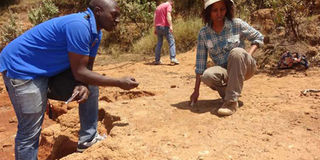Early man tools find sparks new research ideas

Mr John Mwangi, a collector at the National Museums of Kenya, with Dr Veronica Waweru in Eor-Enkitok, where the stone tools were found, attracting researchers. PHOTO | GEORGE SAYAGIE | NATION MEDIA GROUP
What you need to know:
- The haul of picks, flakes and hand axes was found in Eor-Enkitok, Narok North Sub-County, last week.
- The five researchers said the stones were among the oldest tools made by our ancestors.
- Dr Veronica Waweru said the tools were an indication of more sophisticated stone tool-making techniques, probably developed by ancestors of modern humans and that could change the concept of man’s origin and development.
Scientists have discovered advanced stone tools in Narok County in what is likely to place the region on the global archaeological map.
The haul of picks, flakes and hand axes was found in Eor-Enkitok, Narok North Sub-County, last week.
They are believed to be among the oldest tools used by our human ancestors.
The find followed the discovery of a hand axe by Mr Patrick Yiapan, when he was grazing his livestock.
Out of curiosity, Mr Yiapan took the tool to a museum, prompting archaeologists and other experts to visit the farm.
The five researchers said the stones were among the oldest tools made by our ancestors.
The scientists said it was astonishing that the stone flakes — believed to be thousands of years old — were found in the highlands.
“This will spark a new frontier for research since it has for long been believed that our ancestors lived in lowlands because they are warm,” Dr Christine Ogolla, an archaeologist, told the Nation.
“It will create a new dilemma to the history and evolution of humans.”
She added that the field survey would help researchers to collect rock samples, which would tell what archaeological culture was represented, the age of the tools and if possible, look for any bones to determine the ancestors who made and used the tools.
USED FOR CUTTING
Dr Veronica Waweru, another archaeologist, said the tools were an indication of more sophisticated stone tool-making techniques, probably developed by ancestors of modern humans and that could change the concept of man’s origin and development.
“The findings include sharp stone flakes, sheared off from larger rocks, which were most likely used for cutting, and sharpening. The discovery suggests that there are older human fossils yet to be discovered,” Dr Waweru said.
The Yale University Department of African Studies don added that the National Museum of Kenya would carry out an analysis on what type of stones and the period they were used then compare with findings from other places.
This would enable researchers to write a conclusive report on what age the tools were from.
She said the discovery could suggest that human ancestors were making tools hundreds of thousands of years before the genus Homo arrived on the stage.
“We are still looking at these stone tools and trying to get the information we need,” Dr Waweru said.
“We want to determine when they were made and know exactly what age our ancestors used them.”
Dr Job Kabii, a paleoanthropologist, said the Narok discovery might go into history books and join previous evidence collected from other sites, where the oldest stone tools made by our ancestors have been discovered. Such sites include Lomekwi in Turkana County, where tools dating back to 3.3 million years were found.
Dr Kabii said the excavations offered a new look at how early hominids used the landscape and how they responded to environmental changes.





